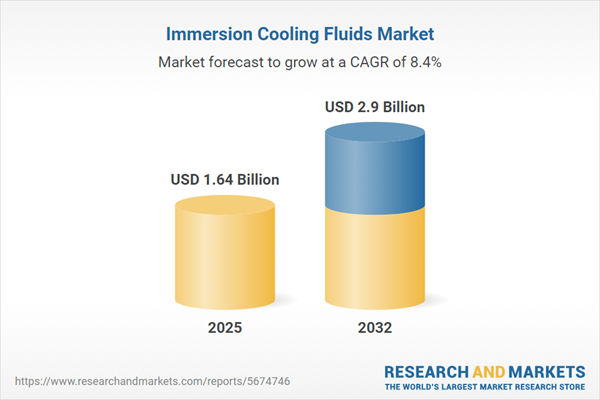Speak directly to the analyst to clarify any post sales queries you may have.
Immersion cooling fluids are redefining thermal management strategies across advanced data center and high-performance computing environments, enabling organizations to address rising energy and reliability demands through direct liquid cooling techniques tailored to modern infrastructure needs.
Market Snapshot: Immersion Cooling Fluids Market
The immersion cooling fluids market is experiencing robust momentum, expanding from USD 1.51 billion in 2024 to USD 1.64 billion in 2025 and projected to achieve a CAGR of 8.44% to reach USD 2.90 billion by 2032. This growth is propelled by the increasing adoption of advanced computing systems, a strong industry focus on sustainability, and evolving regulatory frameworks impacting energy usage. Senior decision-makers are evaluating how direct immersion technologies can be leveraged for cost savings, operational efficiency, and compliance as power densities in critical facilities continue to rise.
Scope & Segmentation of the Immersion Cooling Fluids Market
The report provides a comprehensive analysis of the global immersion cooling fluids market, with segmentation based on fluid chemistry, system configuration, application areas, user categories, and sales channels. Coverage also extends to innovation trends and competitive dynamics across multiple regions.
- Types: Single phase fluids (including mineral and synthetic oil formulations), two phase fluids (fluorocarbon-based and hydrofluoroether-based chemistries)
- Deployment Models: Closed loop systems, open bath systems
- Applications: Cryptocurrency mining, data center cooling, high performance computing, power electronics, telecommunication infrastructure
- End Users: Cloud service providers, colocation providers, enterprises and SMEs, hyperscale data centers
- Sales Channels: Offline sales, online sales (brand websites, ecommerce platforms)
- Regional Coverage: Americas (North America, Latin America), Europe, Middle East & Africa, Asia-Pacific (key countries detailed within each region)
- Key Companies Analyzed: 3M Company, BASF SE, Cargill Incorporated, Castrol Limited, Dow Chemical Company, ENEOS Corporation, Engineered Fluids Inc., Exxon Mobil Corporation, FUCHS SE, Fujitsu Limited, Green Revolution Cooling Inc., Iceotope Limited, LiquidStack Inc., Lubrizol Corporation, Nynas AB, Shell plc, Solvay S.A., Submer Technologies S.L., The Chemours Company, TotalEnergies SE, Valvoline Inc.
Key Takeaways for Decision-Makers
- The shift toward immersion cooling is driven by greater power density in critical systems and the need for reliable thermal management that conventional air-based solutions cannot provide.
- Enterprises are optimizing chassis and facility designs to accommodate single-phase and two-phase systems, balancing performance with maintenance and energy efficiency requirements.
- Regulatory and corporate sustainability mandates are accelerating adoption, particularly where reducing energy consumption, water use, and emissions is essential.
- Segment growth varies: cloud and hyperscale providers are leading deployments, while demand is increasing in telecommunication and power electronics sectors due to equipment durability needs.
- Sales channels are diversifying, with online platforms gaining traction for expedited procurement but offline channels remaining critical for custom engineering and technical support.
- Fluid chemistry advances, including eco-friendly and lower global warming potential formulations, are attracting research investment and reshaping product portfolios.
Tariff Impact on Immersion Cooling Fluids
Recently implemented U.S. tariffs on fluorocarbon-based fluid components have prompted a reevaluation of supply chains, with manufacturers shifting toward alternative chemistries and increasing domestic production. Companies able to offer oil-based options or integrate across production lines are better positioned to manage cost volatility. Collaboration between formulators and end users is being used to stabilize pricing and maintain reliable supply despite tariff-related disruptions.
Methodology & Data Sources
This market research integrates secondary sources such as technical journals, industry white papers, and regulatory documentation with primary interviews of chemists, system integrators, and key executive stakeholders. Analytical triangulation is employed to validate findings and deliver a robust, multidimensional view of current dynamics and trends.
Why This Immersion Cooling Fluids Market Report Matters
- Enables executive teams to align cooling strategies with operational and regulatory requirements while identifying emerging investment and cost-optimization opportunities.
- Delivers actionable segmentation and competitor analysis for benchmarking technical preferences, deployment models, and evolving end-user demands.
- Supports procurement leaders in adapting supply management amid shifting tariffs, local production trends, and sustainability pressures.
Conclusion
Immersion cooling fluids are establishing themselves as a critical foundation for sustainable, high-performance digital infrastructure. This report equips stakeholders with the insights needed to navigate technology trends, regional dynamics, and evolving compliance obligations for future-ready strategies.
Additional Product Information:
- Purchase of this report includes 1 year online access with quarterly updates.
- This report can be updated on request. Please contact our Customer Experience team using the Ask a Question widget on our website.
Table of Contents
3. Executive Summary
4. Market Overview
7. Cumulative Impact of Artificial Intelligence 2025
List of Figures
Samples

LOADING...
Companies Mentioned
The key companies profiled in this Immersion Cooling Fluids market report include:- 3M Company
- BASF SE
- Cargill, Incorporated
- Castrol Limited
- Dow Chemical Company
- ENEOS Corporation
- Engineered Fluids, Inc.
- ExxonMobil Corporation
- FUCHS SE
- Fujitsu Limited
- Green Revolution Cooling, Inc.
- Iceotope Limited
- LiquidStack Inc.
- Lubrizol Corporation
- Nynas AB
- Shell plc
- Solvay S.A.
- Submer Technologies, S.L.
- The Chemours Company
- TotalEnergies SE
- Valvoline, Inc.
Table Information
| Report Attribute | Details |
|---|---|
| No. of Pages | 199 |
| Published | October 2025 |
| Forecast Period | 2025 - 2032 |
| Estimated Market Value ( USD | $ 1.64 Billion |
| Forecasted Market Value ( USD | $ 2.9 Billion |
| Compound Annual Growth Rate | 8.4% |
| Regions Covered | Global |
| No. of Companies Mentioned | 22 |









